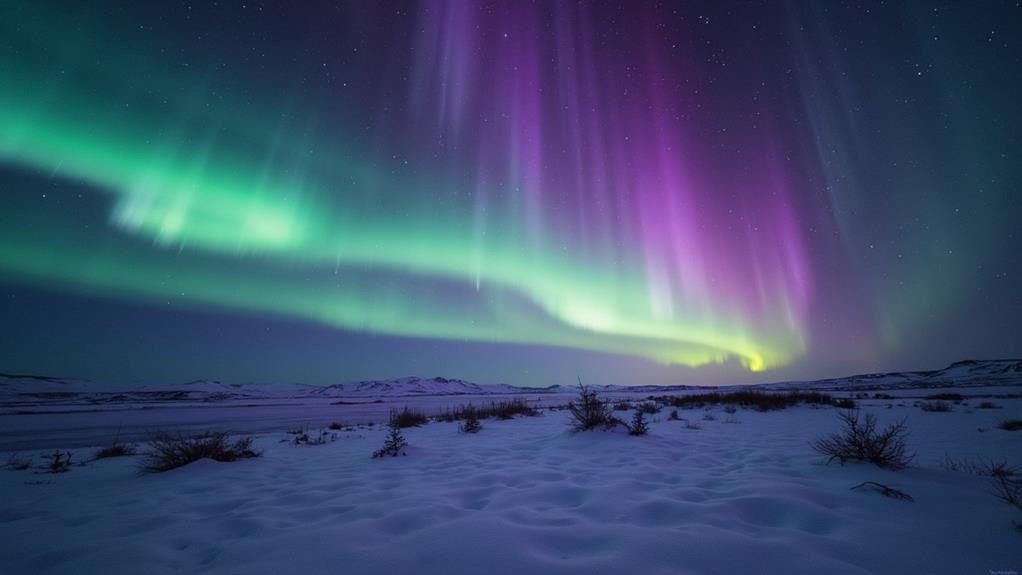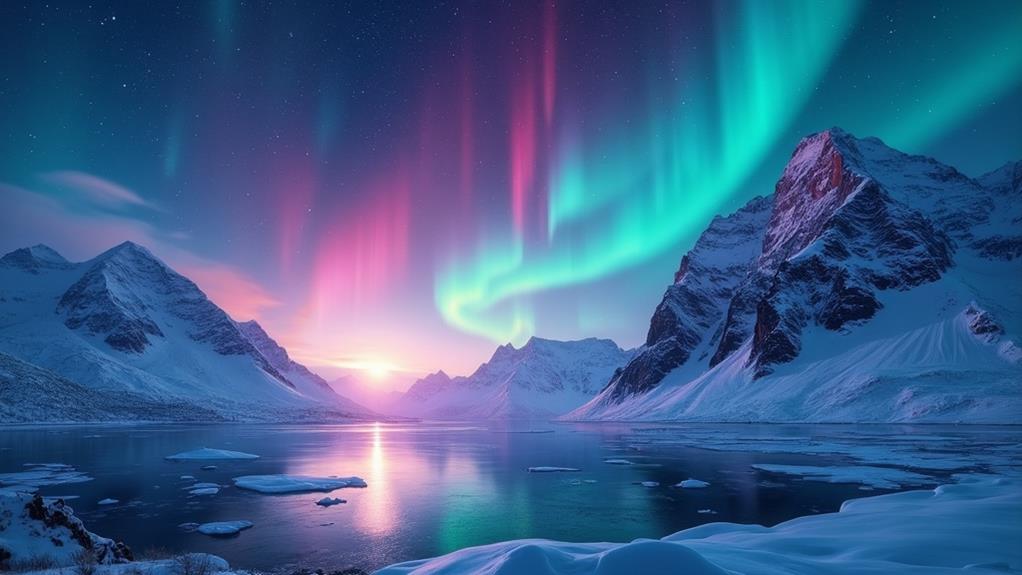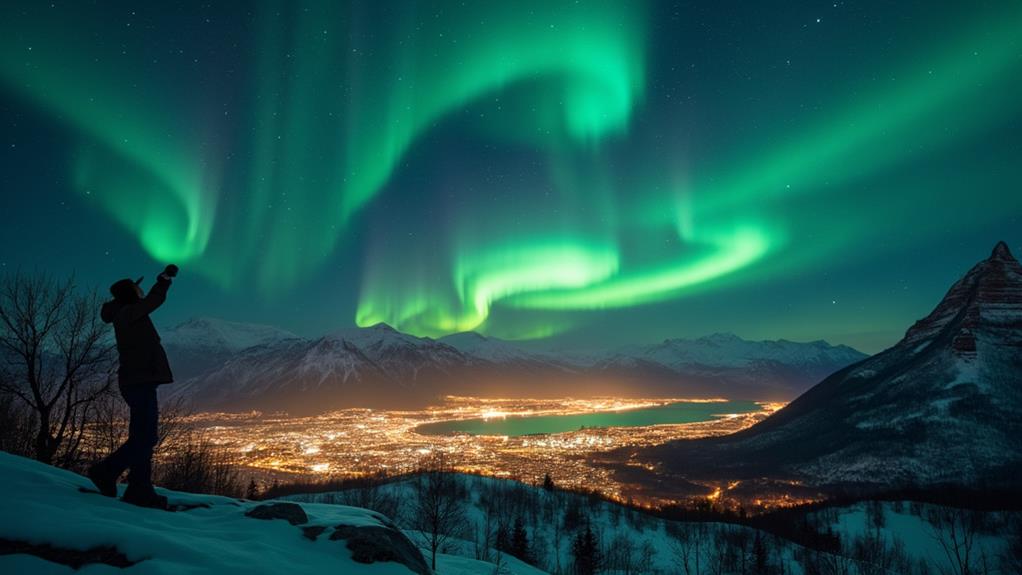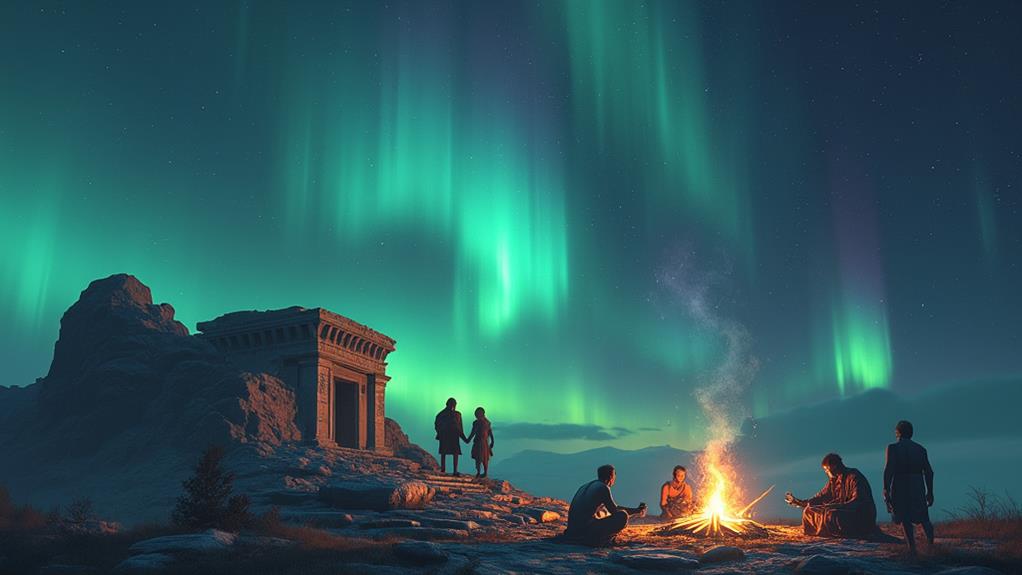Why the Northern Lights Are Rarely Seen in Some Polar Regions
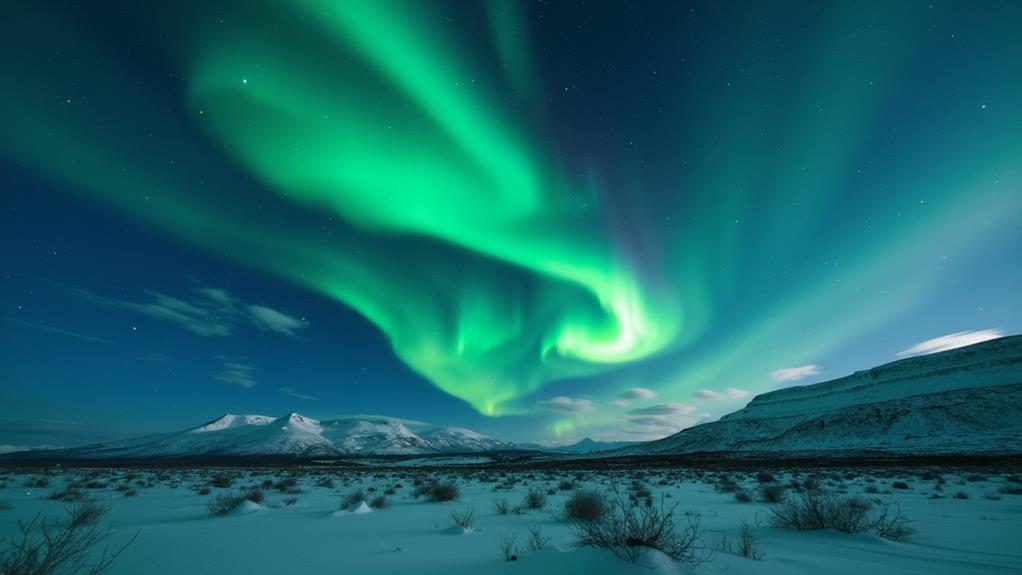
You might wonder why the Northern Lights, known for their stunning displays, are rarely visible in some polar regions. It's not just about being near the poles; geographic and atmospheric factors play significant roles. Locations farther from the magnetic poles experience less auroral activity, and adverse weather can easily obstruct your view. Light pollution from urban areas adds another layer of difficulty, making these natural wonders even more elusive. However, understanding these factors can help increase your chances of witnessing this breathtaking phenomenon. Let's delve into the intricate details that influence your Northern Lights experience.
Geographic Factors
Geographic factors significantly influence the likelihood of witnessing the Northern Lights. Proximity to the magnetic poles is crucial, with ideal sightings typically occurring within a 1500-mile radius. Locations such as Fairbanks, Alaska, are prime spots for viewing auroras. Conversely, areas farther south, like Washington D.C., experience aurora sightings only occasionally.
Latitude plays a pivotal role in aurora visibility. High-latitude locations increase your chances, but even places on the Arctic Circle, like Rovaniemi, may be too far south for consistent displays. Clear skies are also essential; heavy cloud cover can obstruct your view, reducing visibility.
Coastal towns in polar regions often face frequent cloud cover, complicating aurora sightings despite their favorable latitudes. For the best experience, aim for high-latitude areas with clear weather forecasts. Both geographic and magnetic poles dictate ideal viewing spots, but always consider local weather conditions to optimize your chances.
Atmospheric Conditions
Observing the Northern Lights hinges critically on favorable atmospheric conditions. In high-latitude regions, cloud cover is a decisive factor that can either reveal or obscure the auroras. Coastal areas, even those near the poles, frequently deal with cloudiness due to maritime weather patterns, significantly reducing visibility. Therefore, clear night skies are essential; otherwise, atmospheric disturbances such as clouds and humidity can block the view.
Additionally, light pollution from urban areas can greatly diminish your chances of seeing the Northern Lights. For optimal viewing, it is best to be far from city lights. High-altitude locations often offer superior atmospheric conditions, increasing your likelihood of witnessing a clear display. While solar activity is a major determinant of the Northern Lights' intensity and frequency, local weather conditions should not be underestimated. Persistent overcast skies often result in missed opportunities to see these stunning natural phenomena.
Solar Activity Variations
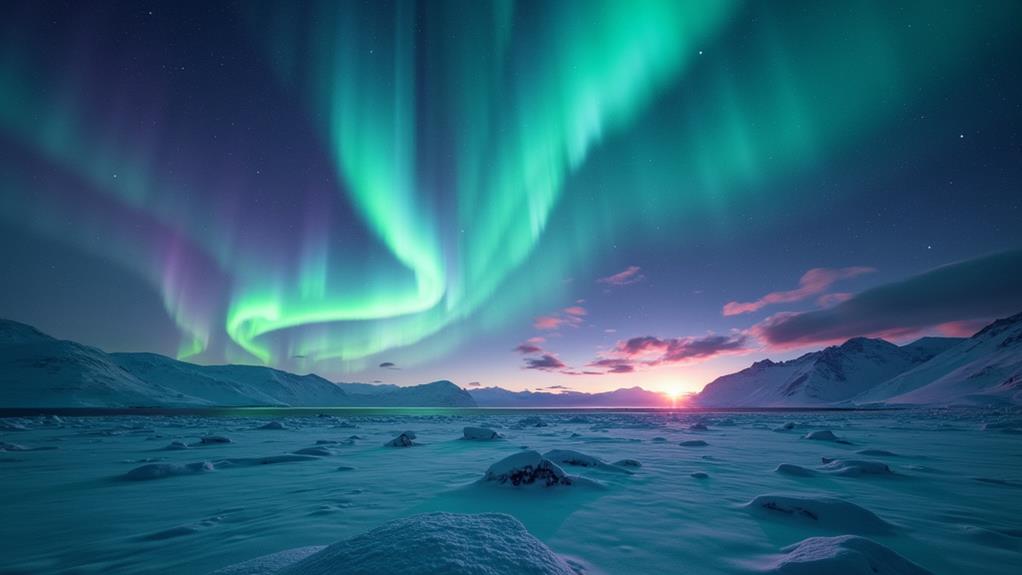
The intensity and frequency of the Northern Lights are closely linked to the sunspot cycle, which peaks approximately every 11 years. During periods of high solar activity, including magnetic storms, auroras are brighter and more widespread, even visible at lower latitudes. Conversely, when solar activity is low, witnessing the Northern Lights becomes rare, even in polar regions.
Sunspot Cycle Influence
Experiencing the dazzling display of the Northern Lights often depends on the sunspot cycle, an approximately 11-year period marked by fluctuating solar activity. During peak phases of the sunspot cycle, solar activity increases, leading to more intense and frequent auroras. This is because the sun releases intense magnetic energy, resulting in solar flares and Coronal Mass Ejections (CMEs) that disturb Earth's magnetic fields.
The solar wind, which varies with sunspot activity, plays a key role in enhancing auroral displays. When the solar wind is strong, it interacts with Earth's magnetosphere, increasing geomagnetic activity and making the auroras more vivid and widespread. Here are some key points to consider:
- Sunspot cycle peaks: Higher solar activity during these periods leads to more spectacular auroras.
- Geomagnetic activity: Increased geomagnetic activity correlates to more frequent and brighter auroral displays.
- Solar wind strength: Stronger solar winds during solar maximum phases amplify the intensity of auroras.
- Magnetic field disturbances: CMEs cause disturbances in Earth's magnetic fields, enhancing auroral displays.
- Aurora visibility: Heightened solar activity can make the Northern Lights visible further south than usual, even reaching midlatitude regions.
Understanding the sunspot cycle's influence explains why the Northern Lights are sometimes a rare sight in certain polar regions.
Magnetic Storm Impacts
Solar activity significantly affects the visibility and intensity of the Northern Lights through magnetic storms. When the Sun releases solar flares or coronal mass ejections, it sends a surge of solar wind towards Earth. This solar wind interacts with Earth's magnetic field, causing geomagnetic storms. During these storms, aurora visibility increases considerably, even reaching midlatitudes where such displays are uncommon.
During heightened solar activity, auroras can be seen as far south as the Yucatan Peninsula, illustrating the power of geomagnetic storms in enhancing auroral displays. The strength of the solar wind is crucial; stronger winds result in more vibrant and widespread auroras. Solar activity follows an approximately 11-year sunspot cycle, with some years featuring particularly stunning and frequent auroras, while other years are less impressive.
Organizations like NOAA's Space Weather Prediction Center (SWPC) monitor solar weather events and provide forecasts on geomagnetic activity. By following these predictions, you can better plan your aurora-watching adventures, especially in polar regions where auroras are more common.
Magnetic Field Influence
Guided by the Earth's magnetic field, which functions like a giant bar magnet, charged particles from the solar wind are directed toward the polar regions, creating the spectacular phenomenon known as auroras. These particles travel along magnetic field lines, striking the atmosphere and producing mesmerizing lights. The auroral zone, typically located around 67 degrees geomagnetic latitude, is where the most frequent and vivid displays occur.
However, the visibility of these auroras can vary depending on your location within the polar regions. Areas further from the magnetic poles experience less frequent auroras because the magnetic field lines diverge, reducing the number of charged particles reaching the atmosphere. Here are key reasons why auroras are rarely seen in some polar regions:
- Distance from Magnetic Poles: Lower frequency of charged particles.
- Geomagnetic Latitude: Ideal viewing around 67 degrees geomagnetic latitude.
- Magnetic Field Line Divergence: Reduces the number of particle collisions with the atmosphere.
- Trapped Particles: Strong magnetic forces can trap particles, preventing visibility.
- Auroral Zone Proximity: Directly influences the likelihood of seeing auroras.
Understanding the magnetic field's influence clarifies why some polar regions don't frequently experience auroras, despite their proximity to the magnetic poles.
Seasonal Timing
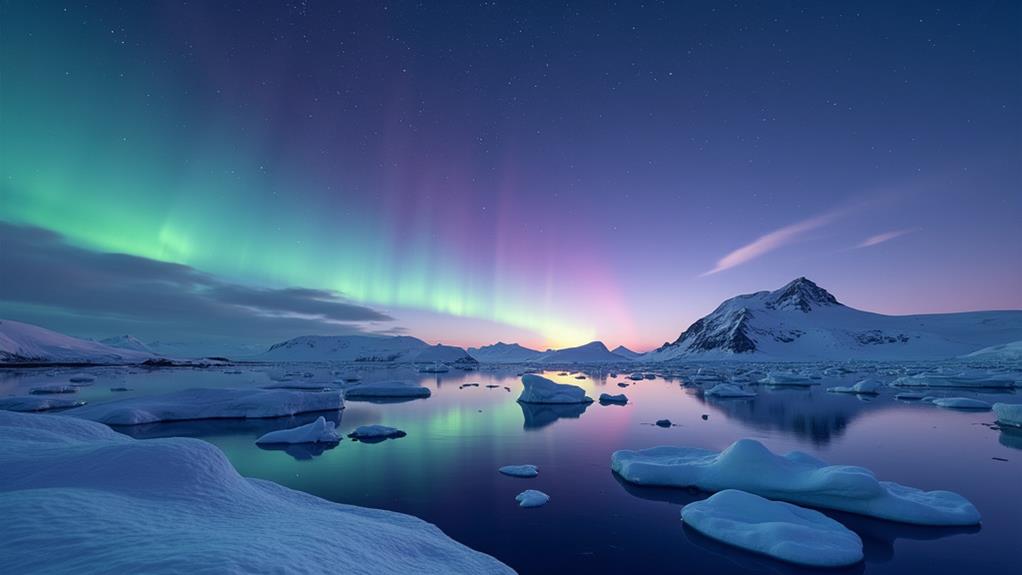
When planning to see the Northern Lights, consider the seasonal timing. From mid-April to early August, the lack of darkness in some polar regions makes sightings rare. The ideal viewing months are from September to March, with December and January being prime months. However, cloud coverage and stormy weather during these months might obscure your view.
Lack of Darkness
Experiencing the Northern Lights in polar regions can be challenging due to the lack of darkness from mid-April to early August. Locations above the Arctic Circle, such as Svalbard, experience continuous daylight, known as the Midnight Sun, which makes it nearly impossible to see the auroras. Despite being geographically ideal for aurora sightings, the bright summer months prevent any chance of witnessing this spectacular phenomenon.
To enhance your chances of seeing the Northern Lights, consider the following key points:
- Continuous daylight: During summer, the sun doesn't set, eliminating the darkness needed for aurora visibility.
- Arctic Circle: Areas within this circle experience the Midnight Sun, impacting your chances.
- Optimal viewing period: Aim for September to April, when nights are longest and skies are darkest.
- Viewing conditions: Dark, clear skies are crucial; summer months don't provide this.
- Missed opportunities: Summer visitors to polar regions often miss out on seeing the Northern Lights due to the lack of darkness.
Plan your trip during the darker months to experience the magic of the Northern Lights.
Cloud Coverage Impact
Despite the allure of the Northern Lights, cloud coverage can be a significant obstacle, especially in polar regions during the winter months. Traveling far north may seem like a surefire way to witness a spectacular aurora display, but heavy cloud cover often obscures visibility, even during peak auroral activity. For instance, places like Svalbard, while geographically ideal for aurora viewing, frequently experience persistent cloud cover, making sightings difficult.
Coastal towns, often positioned further north, also face challenges due to specific weather patterns that result in more cloud cover, reducing your chances of witnessing the auroras. When planning your trip, it's crucial to research the average number of rainy or cloudy days in your chosen location. Abisko is renowned for having the clearest nights, greatly enhancing your visibility opportunities.
Seasonal timing plays a key role in maximizing your chances. Generally, the best period for clear skies and auroral sightings in polar regions is from September to March. During these months, colder temperatures often bring clearer nights, improving your odds of experiencing this natural wonder. Therefore, always consider cloud cover and seasonal timing to increase your chances of seeing the Northern Lights in all their glory.
Seasonal Viewing Windows
Cloud coverage isn't the only factor to consider when planning to see the Northern Lights; the timing of your trip is equally significant. The aurora is rarely visible between mid-April and early August due to the continuous daylight in polar regions during the summer. For optimal viewing, plan your trip between September and March, when the nights are longest and darkest.
To maximize your chances of witnessing this natural wonder, consider these key points:
- Equinoxes: Late September and March are particularly favorable for bright auroral displays.
- Cloud Coverage: December and January may have increased cloud coverage, which can hinder visibility despite being part of the prime viewing season.
- Clear Nights: Locations like Abisko, known for frequent clear nights, are ideal for aurora viewing.
- Seasonal Weather Patterns: Understanding local weather patterns can greatly impact your chances of seeing the aurora.
- Duration of Darkness: Ensure your trip coincides with long, dark nights for better visibility.
Human-made Light Pollution
Human-made light pollution significantly diminishes the visibility of the Northern Lights, especially in urban areas of polar regions. In cities like Reykjavik, Iceland, bright artificial lights obscure the natural brilliance of the aurora, making it difficult to find sufficiently dark spots to fully appreciate this natural phenomenon. This excessive light pollution not only dulls the brightness but also impacts the vivid colors of the auroras, making them appear less impressive to the naked eye.
While one might assume that polar regions guarantee frequent aurora sightings, city lights often thwart these expectations. The International Dark-Sky Association advocates for reducing light pollution to enhance night sky visibility, including the Northern Lights. They promote responsible outdoor lighting practices to improve the chances of experiencing a clear and vibrant aurora.
For optimal viewing, you need to venture into remote wilderness areas where light pollution is minimal. These locations provide the ideal conditions to witness the Northern Lights in their full splendor, underscoring the importance of environmental factors in your aurora experience.
Preparation and Patience
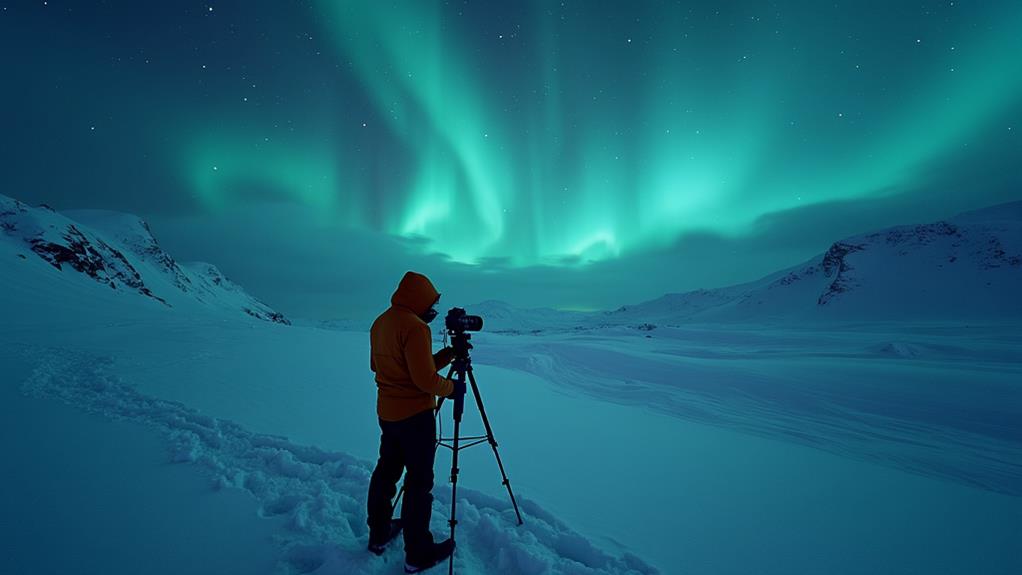
Reducing light pollution is crucial for optimal aurora viewing, but equally important are the preparation and patience needed to fully experience the Northern Lights. Proper preparation is essential to endure the Arctic temperatures, as exposure to extreme cold can be uncomfortable and even hazardous. Standing still in freezing weather intensifies the cold, so wearing appropriate winter clothing is non-negotiable. You'll need thermal layers, insulated boots, and heavy-duty gloves to stay comfortable during long waits.
Patience is also key. The Northern Lights may take over an hour to appear, and giving up too soon could mean missing out entirely. Extended stays—at least five days—significantly increase your chances of witnessing the auroras, as you're allowing more opportunities for favorable conditions. Planning ahead involves understanding that clear skies and high activity levels can fluctuate, so readiness is vital.
Here's how to better prepare:
- Dress in layers: Thermal undergarments, insulated outerwear, and waterproof boots.
- Pack necessities: Hot beverages, snacks, and hand warmers.
- Monitor forecasts: Keep an eye on aurora activity and weather predictions.
- Stay active: Move around periodically to stay warm.
- Be patient: Allocate multiple nights for a better chance of seeing the lights.
Preparation and patience are your best allies in this extraordinary adventure.

